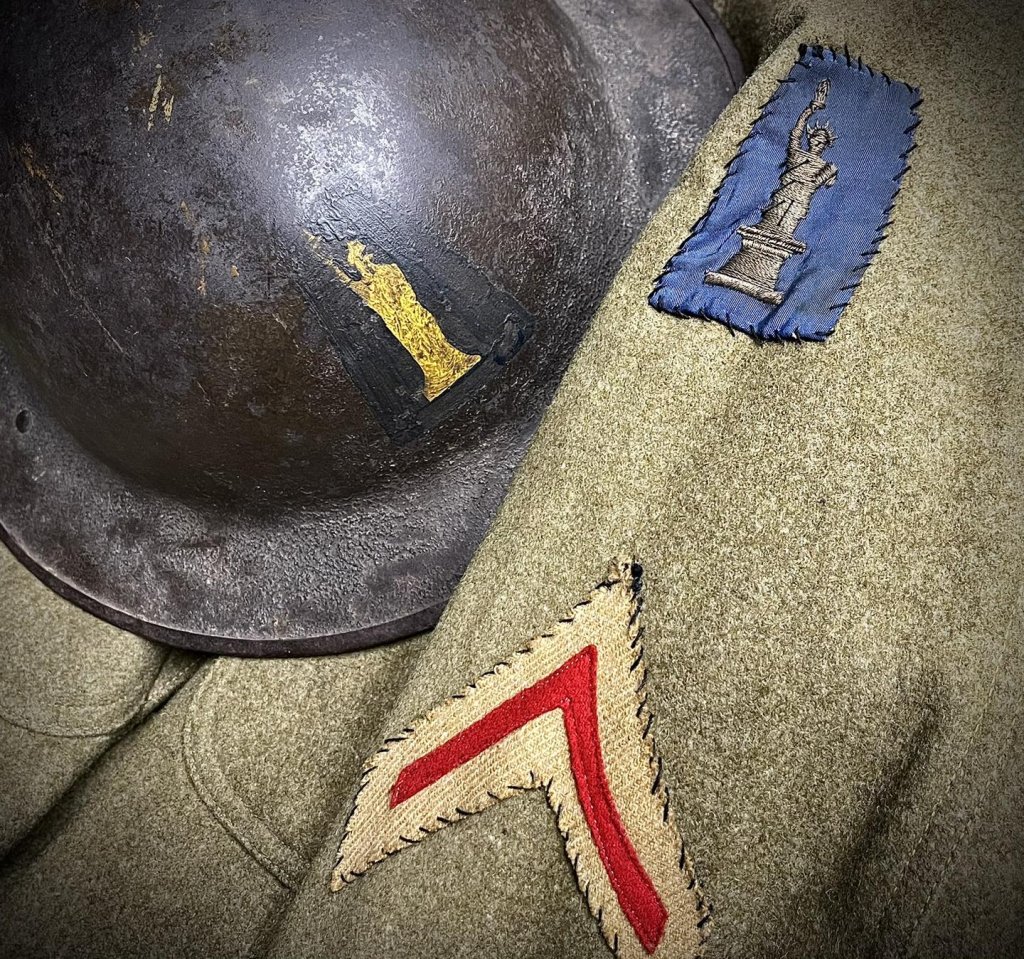From the Collection
"Dressed for Duty: Exploring a WWI Uniform of the 77th Infantry Division
This division was notable for being the first comprised entirely of draftees to reach France during World War I, arriving in April 1918.
May 1, 2024


Uniform of Private Lester E. Mittlestedt. 305th Machine Gun Battalion, 77th Infantry Division. 1917-1919.
The uniform of the American World War I soldier, particularly as seen in the latter part of the war, was distinctive and functional, designed to suit the harsh conditions of trench warfare.
Service Coat: The standard service coat was made of olive drab wool and featured a standing collar, four pockets with flaps, and a button-up front. The coat was practical and provided reasonable insulation against the cold.
 The 77th Infantry Division's unit insignia was both a distinctive and historically significant symbol. Known as the "Statue of Liberty" patch, the insignia features a design of the Statue of Liberty in gold on a blue truncated triangle. The choice of the Statue of Liberty reflects the division's roots in New York City, where the statue stands as a symbol of freedom and democracy.
The 77th Infantry Division's unit insignia was both a distinctive and historically significant symbol. Known as the "Statue of Liberty" patch, the insignia features a design of the Statue of Liberty in gold on a blue truncated triangle. The choice of the Statue of Liberty reflects the division's roots in New York City, where the statue stands as a symbol of freedom and democracy.This emblem was chosen to represent the division's composition largely of draftees from New York City and its surroundings, often referred to as "Metropolitan Division" or "Liberty Division." The design not only embodies the spirit of the city but also the ideals of liberty that the soldiers were fighting to defend during World War I.
The use of the Statue of Liberty image in the insignia provided a powerful and rallying symbol for the troops, encapsulating their mission and the values they stood for. The blue background of the triangle adds to the visual impact of the patch, making it a striking and recognizable unit emblem during and after World War I.

The M-1917 Brodie helmet, often simply called the "Brodie helmet," was a steel combat helmet used by the United States forces during World War I and into World War II. It was originally designed in 1915 by John L. Brodie, a British inventor, and was first adopted by the British Army under the name "Brodie helmet" or "Mark I helmet." The U.S. version, known as the M-1917, was nearly identical in design and function.


Design and Features:
Material: The helmet was made from a single piece of stamped steel, which provided effective protection against shrapnel, a common threat in the trench warfare of World War I.
Shape: It had a wide brim that gave it a distinctive appearance, somewhat resembling a shallow bowl or a wide-brimmed hat. This design helped to protect the wearer's head and shoulders from overhead blasts.
Liner Inside, the helmet featured a leather or oilcloth liner with a leather chinstrap, which was designed for comfort during extended wear.
Protection: While it provided significant protection against flying debris and shrapnel, the Brodie helmet offered limited protection against direct bullet hits or severe impacts.
Adoption: The design was widely adopted by other allied nations during World War I, with variations. For instance, Canada and Australia also used versions of the Brodie helmet.
The M-1917 Brodie helmet represents an important step in the evolution of military personal protective equipment, marking a transition from the cloth and leather headgear of earlier periods to the metal combat helmets that have become standard in modern armies.
The 77th Infantry Division was initially made up of draftees, predominantly from New York City. They underwent training at Camp Upton, located in Yaphank, New York, on Long Island, which later became the site of Brookhaven National Laboratory.

This division was notable for being the first comprised entirely of draftees to reach France during World War I, arriving in April 1918. It was the seventh out of 42 divisions to be deployed to the Western Front. The 77th Division participated in the Battle of Château-Thierry on July 18, 1918, and later took part in the Meuse–Argonne offensive, the largest battle ever fought by the U.S. Army, which lasted from late September until the armistice on November 11, 1918. Throughout its deployment in France, the division suffered significant losses, with 10,194 casualties, including 1,486 fatalities and 8,708 wounded soldiers.